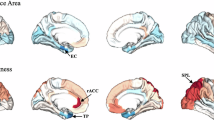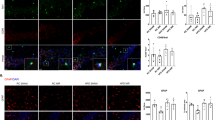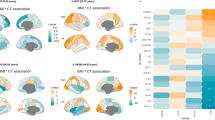Abstract
Background
The spontaneous neural activity alterations and their correlations with cognition, abdominal fat, and liver function in children with obesity remains unclear. This study examined the spontaneous neural activity variations in children with obesity using fractional amplitude of low-frequency fluctuation (fALFF) analysis and correlated the findings with clinical data.
Methods
Fifty-nine children with obesity and forty-eight healthy controls underwent resting-state functional MRI. The brain regions with altered fALFF values between the two groups were extracted and the correlations with clinical data were assessed.
Results
Compared with controls, children with obesity had higher fALFF values in the left insula, left superior temporal gyrus (STG), left middle frontal gyrus and right middle cingulate gyrus (MCG). In the obesity group, fALFF values in the left STG positively correlated with visceral and subcutaneous adipose tissue area and verbal comprehension index. Contrastingly, fALFF values in the right MCG positively correlated with alanine aminotransferase and aspartate aminotransferase levels.
Conclusions
Childhood obesity is associated with impaired spontaneous neural activity in brain regions linked to salience, self-control and inhibition, and verbal comprehension. In children with obesity, language comprehension may be impacted by STG’s neural activity, whilst regional neural activity may be influenced by abdominal fat and liver function.
Impact
-
Childhood obesity is linked to diminished verbal understanding and impaired spontaneous neural activity in brain that handle salience, executive function, and verbal processing.
-
The ability to comprehend language can be compromised in children with obesity due to changes in spontaneous neural activity.
-
Regional spontaneous neural activity may be affected by abdominal fat and liver function in children with obesity.
This is a preview of subscription content, access via your institution
Access options
Subscribe to this journal
Receive 14 print issues and online access
$259.00 per year
only $18.50 per issue
Buy this article
- Purchase on SpringerLink
- Instant access to full article PDF
Prices may be subject to local taxes which are calculated during checkout


Similar content being viewed by others
Data availability
The datasets generated during and/or analyzed during the current study are available from the corresponding author on reasonable request.
References
Gudzune, K. A. & Kushner, R. F. Medications for Obesity: A Review. Jama. 332, 571–584 (2024).
Tanaka, H., Gourley, D. D., Dekhtyar, M. & Haley, A. P. Cognition, Brain Structure, and Brain Function in Individuals with Obesity and Related Disorders. Curr. Obes. Rep. 9, 544–549 (2020).
Li, Z. A. et al. Associations between Socioeconomic Status, Obesity, Cognition, and White Matter Microstructure in Children. JAMA Netw. Open 6, e2320276 (2023).
Quaye, E. et al. Association of Obesity with Cognitive Decline in Black and White Americans. Neurology 100, e220–e231 (2023).
Mora-Gonzalez, J. et al. Physical Fitness, Physical Activity, and the Executive Function in Children with Overweight and Obesity. J. Pediatr. 208, 50–56.e51 (2019).
Martin, A. et al. Physical Activity, Diet and Other Behavioural Interventions for Improving Cognition and School Achievement in Children and Adolescents with Obesity or Overweight. Cochrane Database Syst. Rev. 3, CD009728 (2018).
Bruce, A. S. et al. Brain Responses to Food Logos in Obese and Healthy Weight Children. J. Pediatr. 162, 759–764.e752 (2013).
Davids, S. et al. Increased Dorsolateral Prefrontal Cortex Activation in Obese Children During Observation of Food Stimuli. Int. J. Obes. 34, 94–104 (2010).
Black, W. R. et al. Tonic Hyper-Connectivity of Reward Neurocircuitry in Obese Children. Obesity 22, 1590–1593 (2014).
Moreno-Lopez, L., Contreras-Rodriguez, O., Soriano-Mas, C., Stamatakis, E. A. & Verdejo-Garcia, A. Disrupted Functional Connectivity in Adolescent Obesity. Neuroimage Clin. 12, 262–268 (2016).
Borowitz, M. A., Yokum, S., Duval, E. R. & Gearhardt, A. N. Weight-Related Differences in Salience, Default Mode, and Executive Function Network Connectivity in Adolescents. Obesity 28, 1438–1446 (2020).
Biswal, B., Yetkin, F. Z., Haughton, V. M. & Hyde, J. S. Functional Connectivity in the Motor Cortex of Resting Human Brain Using Echo-Planar Mri. Magn. Reson Med. 34, 537–541 (1995).
Biswal, B. B., Van Kylen, J. & Hyde, J. S. Simultaneous Assessment of Flow and Bold Signals in Resting-State Functional Connectivity Maps. NMR Biomed. 10, 165–170 (1997).
Shahhosseini, Y. & Miranda, M. F. Functional Connectivity Methods and Their Applications in Fmri Data. Entropy. 24, 390 (2022).
Zang, Y. F. et al. Altered Baseline Brain Activity in Children with Adhd Revealed by Resting-State Functional Mri. Brain Dev. 29, 83–91 (2007).
Egorova, N., Veldsman, M., Cumming, T. & Brodtmann, A. Fractional Amplitude of Low-Frequency Fluctuations (Falff) in Post-Stroke Depression. Neuroimage Clin. 16, 116–124 (2017).
Lencz, T. et al. Frontal Lobe Falff Measured from Resting-State Fmri as a Prognostic Biomarker in First-Episode Psychosis. Neuropsychopharmacology 47, 2245–2251 (2022).
National Health Commission of the People’s Republic of China. Ws/T 586-2018 Screening for Overweight and Obesity in School-Age Children and Adolescents (National Health Commission of the People’s Republic of China, 2018).
Ding, Y. et al. Altered Interactions among Resting-State Networks in Individuals with Obesity. Obesity 28, 601–608 (2020).
Pujol, J. et al. Dysfunctional Brain Reward System in Child Obesity. Cereb. Cortex 31, 4376–4385 (2021).
Bubb, E. J., Metzler-Baddeley, C. & Aggleton, J. P. The Cingulum Bundle: Anatomy, Function, and Dysfunction. Neurosci. Biobehav Rev. 92, 104–127 (2018).
Taylor, K. S., Seminowicz, D. A. & Davis, K. D. Two Systems of Resting State Connectivity between the Insula and Cingulate Cortex. Hum. Brain Mapp. 30, 2731–2745 (2009).
Martin-Perez, C., Contreras-Rodriguez, O., Vilar-Lopez, R. & Verdejo-Garcia, A. Hypothalamic Networks in Adolescents with Excess Weight: Stress-Related Connectivity and Associations with Emotional Eating. J. Am. Acad. Child Adolesc. Psychiatry 58, 211–220.e215 (2019).
Liu, L. et al. Structural Changes in Brain Regions Involved in Executive-Control and Self-Referential Processing after Sleeve Gastrectomy in Obese Patients. Brain Imaging Behav. 13, 830–840 (2019).
Garcia-Garcia, I. et al. Functional Network Centrality in Obesity: A Resting-State and Task Fmri Study. Psychiatry Res. 233, 331–338 (2015).
Gunstad, J. et al. Body Mass Index and Neuropsychological Function in Healthy Children and Adolescents. Appetite 50, 246–251 (2008).
Holcke, M., Marcus, C., Gillberg, C. & Fernell, E. Paediatric Obesity: A Neurodevelopmental Perspective. Acta Paediatr. 97, 819–821 (2008).
Braet, C. & Crombez, G. Cognitive Interference Due to Food Cues in Childhood Obesity. J. Clin. Child Adolesc. Psychol. 32, 32–39 (2003).
Binder, J. R. Current Controversies on Wernicke’s Area and Its Role in Language. Curr. Neurol. Neurosci. Rep. 17, 58 (2017).
Chang, E. F., Raygor, K. P. & Berger, M. S. Contemporary Model of Language Organization: An Overview for Neurosurgeons. J. Neurosurg. 122, 250–261 (2015).
Arnoldussen, I. A., Kiliaan, A. J. & Gustafson, D. R. Obesity and Dementia: Adipokines Interact with the Brain. Eur. Neuropsychopharmacol. 24, 1982–1999 (2014).
de, A. B. A. P. et al. Adipose Tissue, Systematic Inflammation, and Neurodegenerative Diseases. Neural Regen. Res. 18, 38–46 (2023).
Lee, C. H., Lui, D. T. W. & Lam, K. S. L. Adipocyte Fatty Acid-Binding Protein, Cardiovascular Diseases and Mortality. Front. Immunol. 12, 589206 (2021).
Ha, J. et al. Relationship between Adipokines, Cognition, and Brain Structures in Old Age Depending on Obesity. J. Gerontol. A Biol. Sci. Med. Sci. 78, 120–128 (2023).
Geng, Y., Faber, K. N., de Meijer, V. E., Blokzijl, H. & Moshage, H. How Does Hepatic Lipid Accumulation Lead to Lipotoxicity in Non-Alcoholic Fatty Liver Disease? Hepatol. Int. 15, 21–35 (2021).
Liu, Q., Bengmark, S. & Qu, S. The Role of Hepatic Fat Accumulation in Pathogenesis of Non-Alcoholic Fatty Liver Disease (Nafld). Lipids Health Dis. 9, 42 (2010).
Li, W., Yue, L., Sun, L. & Xiao, S. An Increased Aspartate to Alanine Aminotransferase Ratio Is Associated with a Higher Risk of Cognitive Impairment. Front. Med. 9, 780174 (2022).
Acknowledgements
We thank Home for Researchers editorial team (www.home-forresearchers.com) for language editing service. This work was supported by the grants from Zhejiang Provincial Natural Science Foundation (LY18H070003 and LY19H180003), National Natural Science Foundation of China (82071902), and Wenzhou Science and Technology Bureau (No. Y20220066).
Author information
Authors and Affiliations
Contributions
Each author has met the Pediatric Research authorship requirements. K.L., Z.C., Z.Y. and P.L. had substantial contributions to conception and design, acquisition of data, analysis, and interpretation of data. K.L. drafted the article. Z.C., M.H., X.H., J.S., X.Y., Y.Z., S.C. and X.L. had substantial contributions to acquisition of data and analysis of data. Z.Y. and P.L. revised the article. All authors are in agreement with the content of the manuscript.
Corresponding authors
Ethics declarations
Competing interests
The authors declare no competing interests.
Ethical approval
The current study was approved by the Research Ethics Committee of The Second Affiliated Hospital and Yuying Children’s Hospital of Wenzhou Medical University.
Consent for publication
Informed consent was obtained from the guardian of each child before study participation.
Additional information
Publisher’s note Springer Nature remains neutral with regard to jurisdictional claims in published maps and institutional affiliations.
Supplementary information
Rights and permissions
Springer Nature or its licensor (e.g. a society or other partner) holds exclusive rights to this article under a publishing agreement with the author(s) or other rightsholder(s); author self-archiving of the accepted manuscript version of this article is solely governed by the terms of such publishing agreement and applicable law.
About this article
Cite this article
Liu, K., Cai, Z., Huang, M. et al. Altered spontaneous neural activity and its association with cognition, abdominal fat and liver function in children with obesity. Pediatr Res (2025). https://doi.org/10.1038/s41390-025-03995-1
Received:
Revised:
Accepted:
Published:
DOI: https://doi.org/10.1038/s41390-025-03995-1



